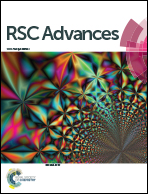Synthesis, structure and magnetic properties of graphite carbon encapsulated Fe3C nanoparticles for applications as adsorbents
Abstract
This paper reports the synthesis of graphite carbon encapsulated Fe3C nanoparticles (Fe3C/GC NPs). Melamine is used as a carbon source for the generation of Fe3C, and hexadecyltrimethylammonium bromide (CTAB) is used as a templating agent for the generation of mesoporous carbon and conversion of Fe to Fe3C in the synthetic process. The Fe3C/GC NPs exhibited a high saturation magnetization value (61.5 emu g−1). Due to their mesoporous structure, the Fe3C/GC NPs are employed to remove methylene blue from waste water, and they exhibited excellent adsorption properties. The current synthetic approach is versatile and scalable, and thus opens the door towards the larger-scale synthesis of mesoporous and graphite carbon-based metal materials.


 Please wait while we load your content...
Please wait while we load your content...